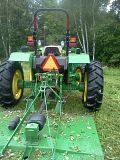k0ua
Epic Contributor
A cubic foot of concrete weighs from about 145 to 150 lbs. There are exceptions of course
Looks great. What is the weight of 1 cf of dry concrete? How did you chamfer the corners?
The owners manual for your loader should have recommendations for you. Mine recommends filled rear tires and 2000lbs on the 3 point hitch when doing heavy loader work such as stone or manure.
Having the loaded tires is handy as it is out of the way and always with you and balances out the weight of the loader arms and bucket. Also they aid traction when pulling a tool that is on the ground and not pressing down on draw bar or the 3PH. They also aid in stability as the fluid is mostly below the axle and helps lower your center of gravity. With just the filled rears I'm not afraid to do a bucket or two now and then or lift a log when needed but if I was going to bail manure all day I'd certainly want to load up the 3PH. I'm going to get another plastic barrel and stick a TSC cross bar in it and fill it 3/4 full of concrete and rocks. I'm going to see if I can set my draw bar out enough to rest the barrel on when in use so as to not constantly stress the seals.

Do ALL OEM's recommend some sort of ballast or weight added to the rear of their tractors with a frontend loader? I never had FEL before, and I was going ask are you guys using the tractor for more than it's designed or do you want the extra security of the extra weight. But from the above quote, it looks like his tractor manufacturer recommends extra weight.

Hi Ron, Do you have any pics to share of your set up? Personally, I keep my BH on most of the time, only removing it to put the back blade or rake on but I do see myself someday using a ballast if it could easily be attached and loaded.This is probably not applicable to the larger tractors but for my fellow SCUT guys this is my solution. The tires on a SCUT are too small to really add effective weight by loading them plus once there you cannot adjust that weight. I made a rack that attaches with pins to my QH to hang suitcase weights. I have 500# in 10 50# increments. That way i have some adjustment room to not overload the rear axle. It works so well my next step is to devise a way to attach the same rack to the front end fro when I want the FEL off to counterbalance rear loads. My chipper almost lifts the front tires to the non-steering point even with the FEL on. This is probably not the answer for everybody that has a SCUT but works for me.
Ron
An aspect to consider.
Every pound BEHIND the rear axle adds to the rear tire loading not only the ballast weight, but also the weight that is take off the front axle.
Taken to exteme for the sake of visualisation, If your front axle carried a 1000 pound load, and rear ballast was added to "float" the front tires, that 1000 puond load would now appear ON the rear axle and tires. That would be the full weight of the tractor, PLUS the weight of ballast.
Chloride (or beet juice) in the tires won't do that. ;-)